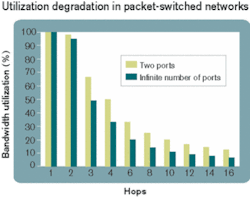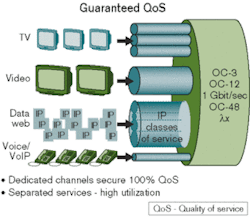When it comes to broadcast networks, is SONET/SDH ready for prime time?
Broadcasters use fiber-based networks to transport live and taped programming to and from remote locations, central offices, and affiliates today more than ever. This is not an isolated development; it affects how broadcasters deliver programming and what viewers expect from video-related services.
Professional media services have unique and demanding transport requirements. Even the financial sector, where split-second execution can mean the difference between profit and loss, doesn’t come close to the broadcast industry’s quality of service (QoS) requirements. Broadcasters need to send high-bandwidth video files and real time video streams among multiple locations with guaranteed delivery. When producing studio-quality video, there are huge benefits to sending it uncompressed at full serial digital interface (SDI-270-Mbit/sec) rates because uncompressed video maintains its quality throughout the production and allows faster delivery. Compressed video must also adhere to strict quality parameters. Asynchronous serial interface (ASI) is commonly used to transport MPEG (Motion Picture Experts Group) compressed video to satellite uplinks between studios and for distribution in cable TV networks. When using ASI, PCR (program clock reference) jitter has to stay under 500 nsec for correct decoding. Because the format is compressed, if only one of the frames arrives out of spec, it could make the decoder lose synchronization and take several seconds before the service is restored. In the ad-driven world of broadcasting, even a few seconds of black screen is obviously unacceptable.
The requirements for video transport will increase as broadcasters change from standard definition television (SDTV) to large-scale deployment of high-definition television (HDTV). An HD feed takes up about four times the bandwidth of an SD feed. Today’s delivery mechanisms will not be sufficient to handle the increased bandwidth. Moreover, with HD, there is even less margin for error, as broadcasters will have to answer to consumers paying a premium for the service.
The traditional transport workhorses of the broadcast industry have been satellite and terrestrial ATM and DS-3 (44.736-Mbit/sec) networks. Typically, satellite has been the most convenient solution for field news contribution, event networking, and live broadcasts from recent news sites such as Iraq. But existing satellite capacity is virtually exhausted, and the cost of launching new stations is expensive. Limited satellite capacity will become more of a problem as bandwidth-hogging HDTV comes online.
Fiber is superior to satellite in terms of cost for transferring large quantities of digital video between major sites. For the same amount of money, a network operator can get 10 times more bandwidth between any major city in the U.S. using fiber rather than satellite.
There are more reasons for change than just cost. With the large capacity that fiber offers, it is possible to use less compression and thereby increase the quality of the picture. For sports programming, that is especially important because sports video tends to demand better compression rates when the camera is filming fast action.
Still, satellite transport is not going away any time soon. Its flexibility and the lack of fiber infrastructure that still exists in many locations mean that broadcasters will be using satellite for the foreseeable future. Terrestrial fiber networks will play a larger role, but the transport platforms used by broadcasters will change significantly.
Until recently, broadcasters that used terrestrial networks relied on ATM transport primarily because it was the only protocol offered by telecommunications providers, who are used to selling data and telecom services. For broadcasters that require reliable video service, however, one size did not fit all.
The broadcast industry is relaxing its grip on ATM as the preferred terrestrial technology. Service providers helped to seal ATM’s fate by not investing in the technology, which in turn has led to declining research and development efforts from equipment manufacturers. The ATM networks still used by the broadcast industry for professional media services stem solely from existing contracts and legacy equipment that still isn’t ready to be written off.
Although few broadcasters will shed tears for ATM as its last chapter is written, the notoriously conservative industry is not looking forward to change. ATM had numerous flaws, but broadcasters were aware of these issues and knew the possibilities and limitations of the technology. With ATM falling out of favor because the technology isn’t keeping up with future requirements, what’s next for broadcast terrestrial networks?
Today, most network operators won’t argue against the crowning of IP as the king of data services; IP because of its ubiquity has been very successful. This realization has made the major carriers announce, one after the other, their intention to migrate their networks over to a complete IP infrastructure. This long-term network strategy makes a lot of sense for the majority of their customers, who want data and voice services. But for the broadcast industry, that may not be good news.
MPLS, an emerging protocol used in tandem with IP, offers a way to emulate a circuit-switched network to achieve the QoS of TDM and the bandwidth utilization of IP. However, IP, MPLS, and Ethernet all rely on asynchronous packet switching; as such, these networks will undoubtedly face congestion issues as traffic increases. The only way to avoid this congestion is to underutilize the network. Simply put, it is impossible to coordinate the asynchronous senders in the network. This lack of synchronization results in senders issuing packets at the same time, which even with rate control is impossible to regulate. The end result is lost packets and interruption of the video signal. In IP/Ethernet transport, QoS is proportional to the number of switch hops the packets cross on their journey through the network. Prioritization does not help this problem; in a video network, the bulk of the traffic is high-priority, effectively reducing performance back to that of a best-effort network (see Figure 1).The reality is that although massive investments in IP/MPLS technology have enabled services with very good service-level agreements (SLAs), there is still a long way to go before the average broadcaster is going to put the six o’clock news on an IP network to transmit programming to an uplink station. QoS requirements remain a key issue. An SLA from a U.S. carrier, for example, promises 99.9% availability on its IP network with a maximum of 2-msec jitter. That equates to a downtime of almost nine hours per year.
Still, IP will have its place in broadcast transport. As the workspace environment continues to evolve to digital technology, professional media will move from tape and analog workstations to files and PCs. The advantages of digital technology are obvious since money and time can be saved working this way. IP will doubtlessly be the glue that connects professional media communications together, whereas today, people send tapes via overnight couriers.
Broadcasters, meanwhile, are looking beyond their traditional service providers. In Europe, several major broadcasters built their own networks. The European Broadcast Union, the largest professional association of national broadcasters in the world with 72 active members in 52 countries, and West Deutsche Rundfunk, Germany’s largest broadcaster, all built intercity networks using a combination of existing dark fiber and leased lines from local telecom operators. In the U.S., Broadwing Communications recently launched a professional media services network after identifying that American broadcasters were unhappy with what the incumbents were offering, especially their lack of strategies to offer HD transport services.
Each of these media transport networks is based on next-generation (NG) SONET/SDH, a synchronous circuit-switching technology inherently designed for real time high-bandwidth transport. To further enhance the technology’s suitability for broadcasters and media network operators, the SONET/SDH platform was enhanced with specific video interfaces (SDI and ASI) and additional standards to provide end-to-end signaling, any rate switching, and scalable multicast support.
As a synchronous technology, SONET/SDH preserves timing, which results in no packet loss regardless of the number of hops. Using the enhanced SONET/SDH platform, each traffic stream on the network is allocated the bandwidth it needs, resulting in a cost-effective network with high bandwidth utilization.Using a NG SONET/SDH platform, Broadwing is able to provide its professional media customers with traditional video services as well as IP and TDM. Traffic from different sources remains isolated on the network through the use of separate channels (see Figure 2). That means bursty IP traffic cannot interfere with real time video streams. As a result, Broadwing can offer both legacy video services such as analog TV as well as new services like HD video, high-speed file transfer, and video multicast over the same platform. Even over a public network, integrity and reliability comparable to a private network is maintained.
Only NG SONET/SDH platforms are able to provide the type of true convergence that broadcasters require because of the technology’s ability to guarantee QoS for any application, be it IP or NTSC. With the coming adoption of Generalized MPLS and virtual concatenation in a couple of years, the industry may see the integration of IP/MPLS and NG SONET onto one common infrastructure. Generalized MPLS will allow routing across multiple networks: IP/Ethernet as well as TDM/SONET. This type of ubiquitous infrastructure with a common interface may put to rest the rivalry between TDM and packet-based technologies. Until then, NG SONET/SDH seems to be in the lead, at least for the broadcast community.
Christer Bohm is chief technology officer and Erling Hedkvist is channel sales manager at Net Insight (Stockholm). The authors can be reached via the company’s Website, www.netinsight.net.


